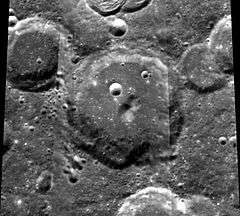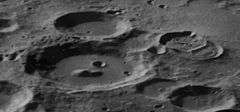Sarton (crater)
Sarton is a lunar impact crater that lies beyond the northwestern limb of the Moon, on the far side from the Earth. It is located to the southwest of the crater Coulomb, to the north of the walled plain Landau. Nearly attached to the northwestern rim is the smaller Weber.
 Clementine mosaic | |
| Coordinates | 49.3°N 121.1°W |
|---|---|
| Diameter | 69 km |
| Depth | Unknown |
| Colongitude | 122° at sunrise |
| Eponym | George A. L. Sarton |

Although roughly circular, this is a somewhat oddly shaped crater that is slightly elongated to the south. The western and eastern outer rims are slightly straightened, giving the crater a slightly hexagonal form. The inner wall is wider along the southern and southeastern sides than in the north. The crater is worn and its features have lost some definition. The interior floor is nearly level, with the exception of a double-peaked central rise. To the northwest of this ridge is a small, cup-shaped crater.
Sarton lies within the Coulomb-Sarton Basin, a 530 km wide impact crater of Pre-Nectarian age. The craters Sarton Y and Sarton Z are closest to the center of the basin.
Satellite craters
By convention these features are identified on lunar maps by placing the letter on the side of the crater midpoint that is closest to Sarton.
| Sarton | Latitude | Longitude | Diameter |
|---|---|---|---|
| L | 47.0° N | 120.0° W | 48 km |
| Y | 51.5° N | 121.3° W | 26 km |
| Z | 51.6° N | 120.6° W | 29 km |
References
- Andersson, L. E.; Whitaker, E. A. (1982). NASA Catalogue of Lunar Nomenclature. NASA RP-1097.CS1 maint: ref=harv (link)
- Blue, Jennifer (July 25, 2007). "Gazetteer of Planetary Nomenclature". USGS. Retrieved 2007-08-05.CS1 maint: ref=harv (link)
- Bussey, B.; Spudis, P. (2004). The Clementine Atlas of the Moon. New York: Cambridge University Press. ISBN 978-0-521-81528-4.CS1 maint: ref=harv (link)
- Cocks, Elijah E.; Cocks, Josiah C. (1995). Who's Who on the Moon: A Biographical Dictionary of Lunar Nomenclature. Tudor Publishers. ISBN 978-0-936389-27-1.CS1 maint: ref=harv (link)
- McDowell, Jonathan (July 15, 2007). "Lunar Nomenclature". Jonathan's Space Report. Retrieved 2007-10-24.CS1 maint: ref=harv (link)
- Menzel, D. H.; Minnaert, M.; Levin, B.; Dollfus, A.; Bell, B. (1971). "Report on Lunar Nomenclature by the Working Group of Commission 17 of the IAU". Space Science Reviews. 12 (2): 136–186. Bibcode:1971SSRv...12..136M. doi:10.1007/BF00171763.CS1 maint: ref=harv (link)
- Moore, Patrick (2001). On the Moon. Sterling Publishing Co. ISBN 978-0-304-35469-6.CS1 maint: ref=harv (link)
- Price, Fred W. (1988). The Moon Observer's Handbook. Cambridge University Press. ISBN 978-0-521-33500-3.CS1 maint: ref=harv (link)
- Rükl, Antonín (1990). Atlas of the Moon. Kalmbach Books. ISBN 978-0-913135-17-4.CS1 maint: ref=harv (link)
- Webb, Rev. T. W. (1962). Celestial Objects for Common Telescopes (6th revised ed.). Dover. ISBN 978-0-486-20917-3.CS1 maint: ref=harv (link)
- Whitaker, Ewen A. (1999). Mapping and Naming the Moon. Cambridge University Press. ISBN 978-0-521-62248-6.CS1 maint: ref=harv (link)
- Wlasuk, Peter T. (2000). Observing the Moon. Springer. ISBN 978-1-85233-193-1.CS1 maint: ref=harv (link)